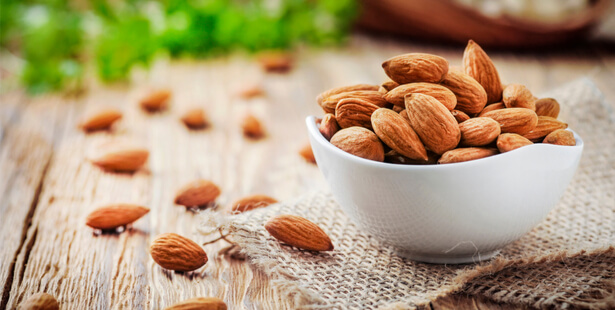After the age of 50, women need more calcium to offset the risks of possible osteoporosis. But what to do when you suffer from lactose intolerance and dairy products are banned from your diet? What are the sources of calcium other than milk?
Seniors and especially postmenopausal women see their calcium needs increase. But how to stock up on this nutrient necessary for maintaining good bone and dental health when we don’t consume milk? This is our practical case of dietetic of the week.
If we eliminate milk, what are the other sources of calcium?
Calcium is found in several families of foods other than dairy products:
- fatty fish
- spices and herbs
- nuts and seeds
- vegetables, especially green
- mineral-enriched cereals
- legumes
- mineral waters
If before the age of 50 calcium needs of a woman are 900 mg/day, we advise those who have passed this age (as well as adolescent girls) a dose of 1200 mg/day.
Natural sources of calcium
Calcium is not only found in milk. Here are some tips to help you consume foods naturally rich in calcium.
Herbs and spices
These are therefore the herbs and spices who are the most rich in calcium ! If it is a little difficult to eat 100 g of thyme or cinnamon every day (we would quickly get tired of it), you just have to remember to use them regularly in cooking, just like other spices and chervil.
Thyme is the big winner for its richness in calcium © Ekaterina Kondratova
Seafood
Sardines in oil are also very interesting foods: in addition to their calcium content, they are rich in omega-3, these famous anti-oxidants that are so precious and that we find very little in the diet. . Sardines also have the advantage of having vitamin D which helps fix calcium. So, plan to have sardines in oil on your tables at least once a week!
Nuts
THE nuts – especially almonds, a little less hazelnuts – and dried figs are also interesting sources of calcium. But here too, it is difficult to eat 100 g per day (which represents 110 almonds!). These seeds and fruits therefore constitute a good daily basis, to be consumed regularly at breakfast and as a snack, for example.

Almonds are a good source of calcium © Krasula
Read also – the secrets of the almond
Eggs
Eggs, and more specifically the yolk, are also a good source of calcium. For maximum calcium concentration, favor boiled eggs which can be easily consumed, alternating with other methods of preparation.
Vegetables
THE green vegetables the richest in calcium are spinach, watercress and chard. The others also have it, but in quantities below 60 mg/100 g. Dried vegetables (legumes) are also sources of calcium that must also be counted on, white beans in the lead.
Easy cooking – 9 ways to cook spinach for those who don’t like it
Unlike the other foods mentioned above, it is very easy to eat more than 100 g to 200 g of vegetables per meal (a daily ration of vegetables and fruits ranges from 400 g to 600 g/day). All these vegetables also provide other minerals such as magnesium and potassium, two other allies of calcium, without forgetting all the vitamins and fiber. Put on the menu every day of the week for green vegetables, and at least two to three times a week for dried vegetables.
Average calcium/100 g for:
- green vegetables = 40 mg
- dried vegetables = 45 mg
The bread
The pain complet or full provides 150 mg/100 g of calcium. With these other essential nutrients (vitamins, low glycemic index carbohydrates, minerals), it should be put on the table at every meal.
Food supplements
You can find several kinds of products in pharmacies, health food stores or on the internet. calcium-based food supplements.
Choose a supplement enriched with vitamin D which promotes good digestive assimilation of calcium and phosphorus.
A day rich in calcium without dairy products
Summary table to help you manage your daily calcium intake.
| Meal | foods | Amount of calcium |
| Breakfast | 3 slices (20 g) of wholemeal bread | 90 mg |
| 3 teaspoons of jam | ||
| Calcium-enriched soy yogurt | 120 mg | |
| Cocoa malted powder 1 tablespoon (15 g) | 36 mg | |
| 100% pure grape juice (125 ml) | 88 mg | |
| 5 almonds (5 g) | 12 g | |
| = 346 mg | ||
| Lunch | 1 piece of toast (20 g) wholemeal bread | 30 mg |
| 100 g lapin | 124 mg | |
| 5 g lemon zest | 8 mg | |
| 5 g of thyme | 63 mg | |
| 200 g spinach | 282 mg | |
| 150 g of dough | 22 mg | |
| Calcium-enriched soy dessert | 120 mg | |
| Prune 100g | 48 mg | |
| = 697 mg | ||
| Diner | 1 piece of toast (20 g) wholemeal bread | 30 mg |
| 1 boiled egg | 150 mg | |
| Green salad with herbs (basil, chervil, parsley = 20 g) and sesame seeds (10 g) | 49 mg | |
| Baked potato (150 g) | 14 mg | |
| Fresh apricots (150 g) | 22 mg | |
| = 265 | ||
| TOTAL general calcium | = 1308 mg |

Boiled eggs in moderation © Robyn Mackenzie
Calcium intake: advice from the dietician
It is therefore not that difficult to find sources of calcium other than dairy products… provided you are very vigilant about the – correct – choice of foods that contain it, and eat it as regularly as possible. . It’s a real dietary discipline to put in place so as not to have deficiencies. But it’s definitely worth it.
Don’t be afraid to use herbs and spices to cook! In addition to being rich in calcium, they have other advantages: they delight the dishes and the taste buds and also allow you to add less salt.
Also think about sesame seeds in salads, and oilseeds for snacks. Small but strong! THE “ plant-based milks ”, which we today call “vegetable juices”, are also good allies.
Article updated
consoGlobe also recommends…
Source: www.consoglobe.com


